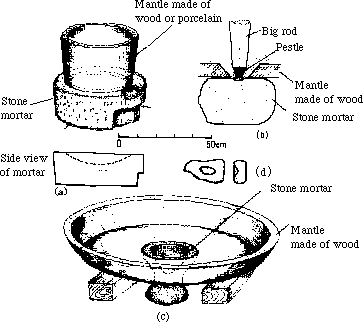
Link:Tofu making:Relation to Buddhism: Gun powder plant in the Middle Ages,Japan and Germany (This page is 36kB)
The History of Grinding Implements for the Domestic Use in Japan Shigeo MIWA
The study of various grinding implements may lead to the study of what is a preferable civilization. There are many works that refer to the history of grinding implements, but they are restricted mainly to the origin of Western wheat flour milling technology as a professional activity, and do not always pay attention to domestic use. It is an interesting fact that almost all the ancient grinding implements devised by humans throughout the history have continued to be used domestically even after the advent of more efficient specialized ones. We can find many examples of this in Japan as well, and some of them have survived to the present day. On the other hand, owing to the recent dramatic change in our life-style, the familiarity of these implements is being rapidly lost in Japan. Therefore, the present work is an attempt to record them in an intelligible form, and to collate them with the Chinese and European ones from the historical viewpoint. Another point to be cited is the very old, traditional grooving of the rotary quern which survives now in Japan. The so-called "counterclockwise revolving, eight-quarter grooving pattern " is the same as that which existed in Europe and China during the Roman period. Though we do not know where and when it originated as yet, this fact is decisive proof of its transmission through the Silk-load in Roman period.
[1] Introduction
From a viewpoint of the material side of human life, a civilization was based on the material preparation technology which can be applied to provide refined materials capable of supplying human needs for everyday life from crude materials in nature. Nowadays, the technology is employed on a large scale for the production of useful constituents from various natural resources. The origin of these technologies is presumed to be almost coexistent with the earliest humans. The most important technology for everyday life was, in the ancient world, the preparation of foods, but this technology was also used for other materials: ores and the like. Because nearly all materials used by man owe their value to the separation of useful constituents, some grinding implements used that purpose would play a most important role in the first step of the preparation process. This paper, based on the information available today, attempts to sketch out a history of the many varieties of grinding implements for domestic use (not for professional activity) which were devised by man before industrial society. Although there have been many such attempts from the Western point of view, they were restricted mainly to the industrial wheat flour milling for East Asian peoples who do not necessarily live on wheat have been developing different varieties of grinding implements for domestic use.
[2] Origin of grinding implements
In the natural world, there are resources which may be used for everyday life directly or after some comparatively simple preparation process. Foods hunted for and gathered earliest humans, which were various kinds of animals, fishes, fruits, edible tubers and so on, could be easily cooked using only simple preparation process. And, in the later period, natural copper, iron sand and alluvial gold could be used as the materials for primitive metallurgical processing by simple preparation methods, for they were naturally, though roughly, prepared resources.
However, cereals, especially wheat, barley, rice, millet and so on, required some tedious processing - threshing, hulling or milling. The wild wheat grains, Iike other cereals, consist of a starchy endosperm or kernel enclosed in a very hard outer sheath and bran, and they are not edible in their raw state. Similarly, with various ores, it is necessary to grind hard ores and collect the useful portion. For such similar materials, the first step of their preparation is the grinding process, which includes threshing and hulling in a broad sense.
An earliest man skinned and cut up the meat of animal with a stone knife or axe. This was also a kind of separation of useful constituents from that body, but his work was, in fact, the direct extension of his own fundamental motion. Even if the material of which the knife or axe was made, was changed from flint to bronze or iron, it would have still remained the direct extension of his teeth or nails, and the tools were only supplementary ones. Unless there had been complicated human regulation for that use, it would have been difficult indeed to accomplish the work. In modern times the knife and axe still survive in their original design, even if the material of which they are made is metal, and the style is refined.
However, in the case of grinding, the situation was quite different. The first man sampling a seed of wild grass would have cracked it with his teeth or his nail, and then, after placing the bulk of the grains in a hollow of a natural stone, he pounded it with a stone, and then blew away the husks. As a result it became easier for him to eat. Using the resulting flour, he could make rough cakes. Because the process of physical change occurring in each grain was complex, and numerous grains were simultaneously processed, he could not regulate them directly. His work was only a simple mechanical action repeated monotonously. It was not the direct extension of the human teeth or nails, but was assuredly a mass processing operation, which held great possibilities for further improvement.
Even if there is evidence, which survives now with the Ainu in Japan (one of the old races of East Asia), to suggest that a wheat grain can be ground to powder with one's teeth, it would, needless to say, be difficult to satisfy the required level of productivity necessary for everyday life.
Then in the course of time, the earliest primitive grinding implement was gradually improved, enlarged and specialized for each purpose. Though there is no clear evidence to tell us what sort of implements were tried, we can easily imagine that man would take one of following three possible ways according to the characteristics of the grains he used:
1) Pounding which would lead to a mortar and pestle and later to a stamp mill.
2) Rolling which would lead to an edge-runner.
3) Rubbing which would lead to a rubbing stone, a saddle quern, and later a rotary quern .
The discovery - or invention - of grinding implements and grinding methods bears very special importance in the history of human beings. The most important achievement was the dramatic increase in human food supply. Many wild grass seeds which had been inedible in their raw state became the source of food when grinding could make them edible. There is a chicken-and-egg aspect to this, though; the discovery could lead to the coming of agriculture. As a matter of course this collecting seeds would have suggested the idea of growing plants for food.
Different courses of development of implements could be seen at different regions of the world, related to the grain available. For example, rice or millet was not necessarily ground to powder, because they could be cooked after only hulling, and, as in China, a mortar and pestle or an edge-runner mill was the major implement developed.
On the other hand, wheat with interpenetrated shell would not be cooked without grinding to powder. In this case, rubbing action was more efficient than pounding.
{3] Mortar and Pestle
The first thing we will discuss is pounding with mortar and pestle, since this would have been applied to all kinds of uses. The earliest grinding implements found from the remains of the Paleolithic era consisted of a roundish stone which was held in the hands and a larger hollowed stone for a bed stone. The hollowness is necessary for efficient impaction and to prevent grain from falling off the stone. Therefore, a round mantle made of hide or wood on the flat bed stone could serve the same function. Since the mantle made of perishable materials is easy to lose, it is difficult to find the certifiable relics of this type of mortar.

(a) Stone mortar for water-powered rice polishing mill (Gifu Pref and Hyogo Pref Japan) (b) Stone mortar for water-powered stamp-mill used to grind raw materials of porcelain (Ehime Pref Japan) (c) Korean mortar surviving only in Cheju (d) Example of small mortar in the Stone Age
Fig.1(a) Reference examples of mortars with a round mantle made of perishable materials in Japan or Korea.
Figures I (a), (b) and (c) are such reference examples surviving in Japan and Korea. It is interesting to compare them with the relics from the Stone Age in Fig. I (d). If the mortar was fixed on the ground, a much larger pestle could be used. Since the mortar and pestle covered a wide range of adaptability, they were normally not specialized for a certain single purpose for a long time. However, they became specialized gradually as one purpose gained predominance over others. Anyone using the mortar and pestle may notice that it works in the following three ways.
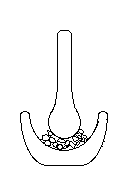 Fig.0.A mortar and pestle in modern chemical laboratory is
almighty, the implement is in modern chemical laboratory. We can certify
following three important functions.)
Fig.0.A mortar and pestle in modern chemical laboratory is
almighty, the implement is in modern chemical laboratory. We can certify
following three important functions.)
1) Hulling - grain surface grinding: If grain with a relatively soft, outside husk is pounded using a pestle with a flat end (Fig.2(a)), the husk is gradually removed, as in hulling and polishing of rice or barleycorn.
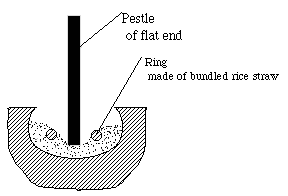 Fig.2(a) A pestle with a flat end
Fig.2(a) A pestle with a flat end
Fig.2(d) Drum shaped mortar and hammer shaped pestle.
The grain is ordinarily moistened with water before being pounded, a practice which appears to have been discovered early in Roman period (l) . In order to promote the grains circulation, usually a ring made of rice straw (Usuwa in Japanese) was inserted into the mortar (13) .
2) Impact grinding: If the end of pestle is roundish (Fig. 2 (b)), it may penetrate through the bed of grains, and grind the grains to powder at the bottom of the mortar.
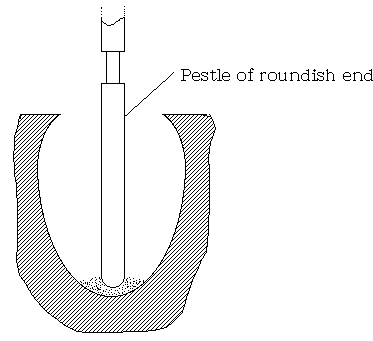 Fig.2(b) Principle of impact grinding with mortar and
pestle.
Fig.2(b) Principle of impact grinding with mortar and
pestle.
From the remains of prehistoric period in Europe, many relics of mortar and pestle had been excavated, but thereafter they seem to have been replaced by the quern, used for wheat; though the stamp-mill has survived until the present day in industry, for instance in powder metallurgy. On the other hand, after the introduction of the foot-driven tilt-hammer or water-powered mill, impact grinding was used widely and still survives in Japan.
3) Rubbing:
Rubbing the pestle against the inner side of the mortar causes reduction of the grain to powder effectively. Poppe(7) attributed the origin of the invention of rotary quern to a revolving pestle in a mortar, and his opinion was quoted by Karl Marx(8) but we remain unconfirmed. An Egyptian tomb painting of about 1450B.C.(Fig.2-0), in which two persons are pounding together in a mortar, and a Greek vase painting of about 500B.C., in which a man and a woman are pounding together, are well known.
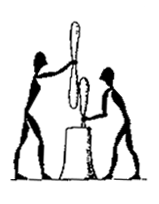 Fig.2-0 An Egyptian tomb painting
Fig.2-0 An Egyptian tomb painting
Particularly interesting is the fact that the double-bell shaped pestle and tree-trunk mortar similar to these ancient Western paintings had survived in Japan until twenty years ago. Since Japanese farmers did not have the rotary quern until about the eighteenth century, the mortar and pestle were most important grinding implements for general use. The earliest excavated evidence of its use in Japan was known in the Yayoi period(400B.C.-400A.D.), when rice cultivation was introduced. It is a matter of debate whether the similarity was based on the fact that a substantially identical problem can lead to very similar solutions in places widely separated in space and time, or on the result of spread in the ancient world. In Japan, the mortar with decorated waist (Fig. 2 (a)), which had ceremonial meaning, and the double-bell shape pestle gradually fell into disuse during the eighteenth century in urbanized regions, and were replaced with hammer pestle and non-decorated drum shape mortar (Fig. 2 (b)) which were more efficient.
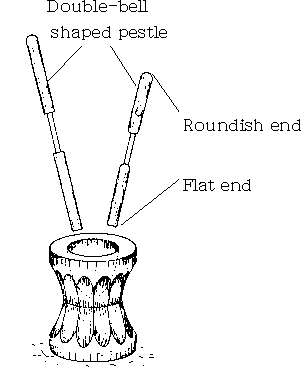
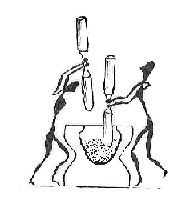
Fig.2(a) Double-bell shaped pestle and mortar with traditional decorated waist as same as painting in Egyptian piramids.
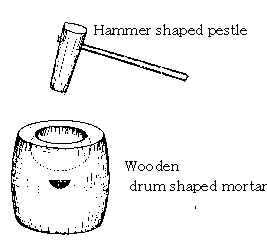
Fig.2(b) Hammer shaped pestle and drum shaped mortar
A reason of the change was a social change of group life to family system in Japan. At present they survive only to make rice cakes in ceremonial use.
Because flour milling was a matter of primary interest in the Western world, the mortar and pestle was abandoned early, probably late in the prehistoric period. However, in other regions, especially in East Asia, they survived for a long time and developed markedly. In China, early in the former Han Dynasty (221 B.C.-9A.D.), foot-driven and water-powered tilt-hammer pestles throve and seem to have been introduced in Japan in about the eighth century.
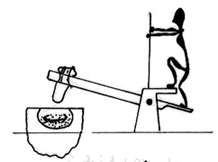 Fig.2(e) Principle
of foot-driven tilt-hammer mill.
Fig.2(e) Principle
of foot-driven tilt-hammer mill.
They were used mainly for hulling and polishing rice and rarely used for making rice cake. They were a familiar sight to the people throughout rural regions and even within the cities to some extent till half-century ago. Earthenware mortar ( in Chinese, Suribachi in Japanese) is a type of mortar for domestic use(l3) . The transmission from China (Song Dynasty, 960-1 279A.D.) to Japan is supposed to have taken place in the thirteenth century, and gradually replaced the stone mortars. The earthenware mortar which has fine grooving on its working surface that cooperates with a wooden pestle to bray the material, and is still widely used for various purposes of household cooking; for example wet grinding or dispersion of "miso" (bean paste), "tofu" (bean curd), yam, and dry grinding of cayenne pepper, sesame seeds and so on.
[4] Edge-runner mill
Another notable development of the primitive mortar and pestle for greatest productivity was replacement of a pestle with a roller, which might have come from the idea of a wagon wheel being used to thresh wheat or other cereals in the ancient world.
The edge-runner mill, commonly employed by Romans for professional use in olive oil production, was one of the established machines.Fig.3(a). It consisted of one or a pair of broad stone wheels freely mounted on a short horizontal axle which was loosely supported with a vertical shaft. Rotation of the shaft caused the wheels to revolve on a circular stone base crushing the olives laid in their path. The mill was driven by slaves or animals and there is no evidence to suggest the use of water power. Later, in Europe, the mill was developed mainly in mining. Fret-mill, Pan-mill and Chilean-mill are now used in the modern industry.
Another fashion was taking place in China for hulling and grinding of cereals (10)
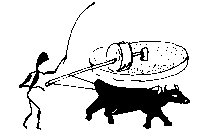 Fig.3(a-1). Chinese shih nien(same as Olive mill in Roman
Fig.3(a-1). Chinese shih nien(same as Olive mill in Roman
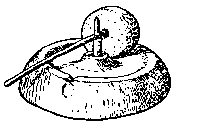 Fig.3(a-2) Olive mill in Roman
Fig.3(a-2) Olive mill in Roman
Chinese Nien was recorded in the second century A.D.(11) and later, there were various designs, for instance, the rotary bogie-wheel edge-runner mill with single roller and the rotary double edge-runner mill with two wheels (Shih-nien in China) and so on(2).
Strangely, there is no evidence of the nien being introduced into Japan, except small scale edge-runner mills with longitudinal travel (man power) (Yen nien in Chinese. Yagen in Japanese) for herb medicine (Fig.3 (b). This implement was used to prepare gun powder.
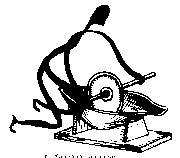 Fig.3(b) Yagen in Japan for grinding medicine.
Fig.3(b) Yagen in Japan for grinding medicine.
[5.] Saddle quern
As described before, rubbing the inner surface of the mortar with the roundish end of pestle could be used for grinding to powder. For such use, a larger rubbing area is a basic requirement. If the size of the upper stone restricted by the fact that one must be able lift it with both hands, one possible way the enlargement of the rubbing area is the use of a flat dish-shaped understone as a grinding slab. The back-and-forth motion of the grinding slab made a shearing action possible under more precise control than the mortar and pestle did. Also it held the possibility of making the grinding process continuous.
In the course of time, probably thousands years of use, this primitive implement gradually developed to more favored mill implement - the fully developed Saddle quern, consisting of a concave lower stone, on which a smaller stone was rubbed to grind the material (Fig.4(a)).
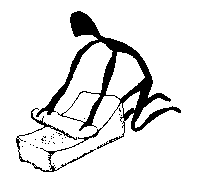
Numerous statuettes from Egyptian tombs depict women kneeling at the saddle querns, grinding meal to offer the dead in the after life.
Saddle querns might have been specialized closely related with the processing of wheat and barley, and were discovered in the relics of Neolithic sites in Africa, Western and Northern Asial(12). A sort of saddle quern "Metate" which consisted of bench- or trough-like bed stone and often made of volcanic rock, was used for grinding maize by the American aborigines (Fig. 4 (b)) . Though in Korea there was some unambiguous proof of the existence of saddle quern, in Japan there is no clear evidence indicating that it was used. Though some dish-shaped relics which resembled saddle quern were excavated from the remains of the Jomon period (before the Yayoi period) in Japan in some rare cases, they are more primitive grinding slabs (Fig.4 (c)).

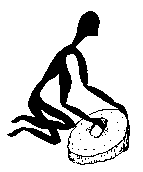
Fig.4(b)Metate used by abonigines (c) Grinding slub (Jomon period in Japan)
[6] Rotary quern
The saddle quern was an extremely advanced tool for grinding, their final form was a result of thousands of years of use and evolution. No further advances could be made in its developmental pathway. On the extension line,we cannot expect more mechanical success.
The rotary quern, consisting of two circular stone discs was the beginning of a new era in grinding technology. However, to this day no decisive proof is available to tell exactly where and when the quem was invented. It is a matter of debate whether the step wise sequence of improvement could have led to the rotation of the wheel, or an intellectual leap suddenly occurred .
There are two findings which are estimated to be intermediate forms in the progression from the saddle to the rotary quern. One of them is a semi-rotary quern employing a circular upper stone mounted on a bed stone which has a hollow holding the upper stone, swung to and fro along an arc by hand. Another one is a lever mill surviving in Greece.
Storck(3) discussed a remarkable find, an ancient and unique relic, now in the Tiflis Museum(2) , which was discovered by the Russian archeologist Tseretheli amongst the remains of Urartu, a Kingdom centering on the highland plains around Lake Van before the eighth century B.C. But how widespread in Asia and Europe such a quern existed is still not fully known, and so only future discoveries will confirm or refute the Urartu quern.
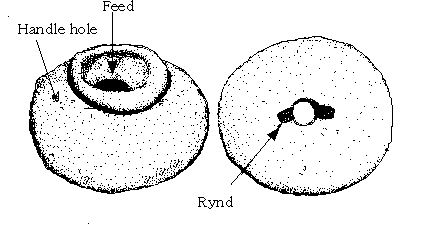 Fig.5(a) Urartu
quern.
Fig.5(a) Urartu
quern.
Beyond the historical blank out for many centuries, many pieces of evidences of various kinds from all over Europe, especially Rome, South-East Asia (Taxila, 600B.C.-500A.D., Par-thia, 1 71B.C.-225A.D.), and China (Ch'in Dy-nasty, 221-206B.C., Han Dynasty, 206B.C.-220A.D.), show that the refinement of rotary quern was accomplished by that age.
It appears that the pot quern (Fig. 5 (a)), which survived for domestic use in medieval times, was introduced into Britain no earlier than the Roman occupation. A wonderful technical refinement in China is particularly interesting. One example is an article buried in a tomb (so-called MINNKI in Chinese) (Fig. 5 (b)).

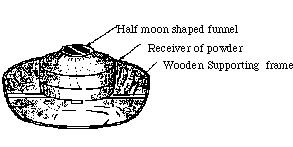
Fig. 5 (b) Rotary quern of Rome and China of Han Dynasty.
Also a stone mill, the diameter of which is 850mm, was excavated. Many other sites in China belonging to this period have produced several varieties of rotary querns. The earliest written evidence concerning the existence of the rotary quern and milling wheat is late Former Han Dynasty (53-1 9B.C.).
[7] Relation to Buddhism in Japan
The introduction of the rotary quern into Japan is closely related to Buddhism. In the oldest chronicle of Japan "Nihon-shoki"(720A.D.),we find the following description: "In March of the spring of the eighteenth year of the Emperor Suiko (61 O A.D.) the King of Korea presented a monk, named Doncho, which made a mill (Ten-gai in Japanese), that was really the first mill in our country, " Another piece of written evidence can be found from the word (Tengai) here and there in the oldest Japanese lawbook "Ryo-no-gige (7 1 8-833A.D.), and in the document of Todaiji , a temple established in 745 A.D.. On the other hand, the era corresponds to T'ang Dynasty (618-906A.D.) in China when many Buddhist temples set up water-mills in their manors and made large profits on them, the beginning of which occurred during the Pei-wei Dynasty (386-534A.D.)(10) .
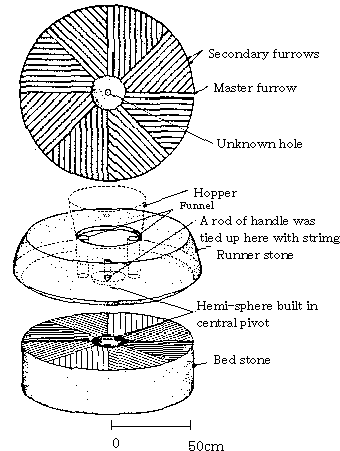
Fig.6. A relic of the oldest and largest millstone in Japan probably imported from Korea in the seventh century (Now preserved in Kanzeonji-temple,Fukuoka Prefecture)
An interesting relic of a large stone mill (Fig. 6) which seems to belong to that period was preserved in a temple Kanzeon-ji in Fukuoka Prefecture - which played an important role in the introduction of culture from China via Korea. Although such a mill was a familiar one in Europe or China, in Japan the form and the size of the mill was surely strange. Then the relic have no signs of working. That is holding new grinding surface. Of particular interest is a hemispherical pivot built in the center. Although Storck(3) discussed such a pivot in the early Palestinian and Hindu querns, it seems to be very rare. Because the basic item of staple food in Japan was rice and barley, wheat was, probably, a rare or novel food for the noble personages at that time. Though the mill might have been harnessed for foreign visitors and the upper classes, it does not appear to have been widely accepted. The introduction of such a large stone mill from Europe for commercial flour milling was curiously about a thousand years later (late the nineteenth century). It appears that the hand operated rotary quern was introduced into Japan no earlier than the thirteenth century . Japanese Buddhist monks who went abroad to China (Southern Sung Dynasty, 1127-1279A.D. to study imported some rotary querns, and Chinese and Korean craftsmen introduced the technology. Earliest written evidence "Daisoshosanzu " (pictures of temples in Sung) preserved in Tofuku-ji in Kyoto. Therefore no archaeological reliable and undisputed fragment of a rotary quern older than that time has ever been found. Even a few centuries after that time, such relics were still rare indeed, and the hand-querns were no larger than about 360mm in diameter. It is an interesting fact that in any ruins of that time, the relics of the rotary quern can be found only in the settlements of the upper classes, not in those of the farmers. Since the seventeenth century the hand-rotary quern has come into widespread use very gradually and only in the eighteenth century did Japanese farmers start to use it for general purpose like grinding of various cereals, or for Tofu making. From China (Southern Sung Dynasty), Buddhist monks had introduced another novel rotary quern which was specialized for producing the green tea powder used for tea-ceremony. Figure 7 shows the hand operated tea-mill (Chausu in Japanese), which was made of a somewhat harder and more beautiful stone (such as diabase or quartzite), than the ordinary querns for cereals. In China, the tradition of tea-ceremony went out of style during the Ming Dynasty (1368-1644A.D.), but in Japan the tradition still survives today. Late the sixteenth century, the tea-ceremony had been all the fashion with the commanders in chief of the Samurai (the warriors of Japan) as a status symbol and sometimes Chausu were heirlooms. The ruins of a castle and the ancient battle fields of that period produce an outstanding profusion of evidence related to the tea-mill. A notable feature of Chausu compared with other querns is an axle which is loosely inserted into the funnel. Thus the upper stone is capable of sliding on the working surface of the bed-stone, and so preliminary crushing of raw materials occurs between the axle and the funnel. Now the stone mill (the diameter of which is about 36cm), driven by an electric motor, survives in commercial production of the powdered green tea (particle size finer than about I 0 micron) for tea-ceremony.
9. Rice-hulling mill in Japan
There were two words "mo" and "lung" in Chinese for the mills. The former means a stone rotary mill, and the latter means a man-operated mill specialized for rice-hulling (decorticating). The lung was made of sun-dried clay - "thu lung" in Chinese, Tousu in Japanese), or made of wood "mu lung" in Chinese, Kizuriusu in Japanese). These were substitutes for the stone mill because they were easy to make.
Damp kneaded clay with a little common salt was used to fix the teeth of oak or bamboo onto the working surface, so that they could act in the same way as the grooves of the stone quern. The pattern of the teeth (Fig.8 (a)) was according to the tradition, the same as that of the stone rotary quern, and was counterclockwise revolving, eight-quarter grooving to be described later. Rice hulling with such a mill required a cooperative and laborious effort by two or three men as shown in Fig. 9 (b).
The lung was introduced into Japan in the seventeenth century and has been widely accepted as an important implement of farmers for domestic use until recently (Fig. 8 (b)).
In Japan there was another form of wooden mill which had radial grooving and was operated, not with continuous revolutions, but by swinging to and fro along an arc of a circle by pulling two strings using both hands of two men or women who sat facing each other on opposite sides of the mill (Fig.9 (a)). Such an implement also has survived until recently in a mountainous district for domestic use only.
10. Principles of the rotary quem
Basic principles of the rotary quern are nearly the same throughout the world, but there are subtle differences from region to region which seem to be important in considering the history of the quern , since they have survived for nearly two thousand years.
l) Bosom The working surface of the lower stone, in principle, was perfectly flat, but that of the upper stone was slightly concave, especially near the centre to admit a little continuous flow of grains. Such an open annular space between two stones was known as a bosom ("Fukumi" in Japanese). Thus, the grains received in this bosom are gradually drawn towards the circumference by the revolution of the upper stone, first being crushed ( by degrees, and then ground and ejected from the mill. Therefore, the upper and lower stones contact each other only at their circumference, so that when mounted they would grind the grains only near the edges.
Superficial thinking would result in the idea that the ground flour must fall down off of the stones by downward force of gravity. Hence, sometimes the lower stone was slightly conical in shape. As the true principles of the working of the appliance became recognized, however, the bed-stone seems to have been gradually flattened.
2) Grooving An early and notable improvement was the grooving of the working surfaces. The grooves or furrows had a typical, traditional pattern which consisted of eight radial master furrows and several secondary furrows parallel to each master furrow (Fig. 10 (b)). Thus the working surface was divided into eight equal segments or harps which were called quarters. "Quarter" was a unique terminology of the millwrights in Europe, since "the quarter is not a quarter"(9) . It is not certain where and when such fully a developed and methodical system of furrowing was first evolved. There is a noteworthy fact that the pattern- counter clock-wise revolving, eight-quarter grooving -seems to be widespread and common throughout Europe and Asia. For instance, the pattern of the British-Roman quern(5) (first century A.D.) is the same as the one surviving in China and Japan.
Besides the eight-quarter pattern, there was a six-quarter pattern in China and Japan. Especially in Japan, a distinct regional distribution was found in the eight -and six quarter(l3) patterns, but as yet we do not know why this distribution occurs or what it might represent (l2).
3) Pivoting
A hole was drilled through the top of the upper stone, forming a kind of funnel which acted as a hopper. As the upper stone revolving, the grains fell down into the bosom.
As shown in Figs.5 and 10, the shape and position of the funnel were different in Europe and in Asia. Consequently, the construction of the pivoting upper stone upon the lower one was different. The existence of a "rynd" (Fig.10(a)) seems to be a prominent feature of the European quern. A pin of wood or iron stood in a hole in the centre of the lower stone, and the top of the pin fit into the rynd. A rynd was a block of wood or iron bridging across underneath the funnel, Ieaving a little space on both sides of it for the grain to percolate through. The gap between the two stones is maintained uniformly. Though primitive adjusting of the fineness was done using a small piece of leather or wood of any desired thickness fixed in the socket of the rynd, a fairly efficient method of regulation was by adjustment of the pivot height. Another exception to the existence of the rynd in Japan is seen in the stone quern of the medieval gold and silver mines, the technology of which was introduced from Europe(l4)
On the other hand, Chinese and Japanese querns had the funnel at an eccentric position, and so there was a pivoting hole in the center of the upper stone. Although the querns of the rynd system were used in some rare cases, especially for "Tofu" making, they, seem to have introduced the European style, since they were no more than one hundred years old.
[11.] Conclusion
In this paper the varieties of grinding implements for domestic use in Japan have been traced, principally excluding the ones used in professional activity, because we can see that almost all of the ancient implements survived for a long time in domestic use. In parallel with the professional activity of flour milling, domestic milling continued to be practiced. The reason for its survival was, needless to say, necessity or economy. However another point to be remembered is that various home made foods made from small quantities of superior materials prepared skillfully using domestic implements were undoubtedly preferred in many households which could obtain the ready-made products from a shop. Particularly in Japan many ancient implements have survived, because throughout the roughly two thousand years since agriculture was introduced into Japan in the Yayoi period, nothing has arisen to replace the old ways of raising crops, at least as far as the wet-field system of rice cultivation is concerned. And so the life style of rural villages has been preserved while the cities have evolved a new culture. For instance, Japanese "Chausu", which was introduced from China many centuries ago, is refined in Japan, and survives today. It is indeed a beautifully made object, artistic instead of technological.
The age in which we live is one of constant change, especially in the last three decades. Everything becomes obsolete almost as soon as it is completed; modem man is prepared to accept it, and tends even to welcome this state of affairs as inevitable. However, some humanity has occasionally been lost, the humanity included in the everyday things in which the human history is condensed. The study of various grinding implements may lead to the study of "what is a preferable civilization.
References
1) Bennett, R., and Elton, J.: History of Corn Milling. Vol.1 Burt Franklin, N.Y. (1898).
2) Needham, J.: Science and civilization in China. Cambridge at the Univ. Press (1 965).
3) Storck, J., and Teague, W.D.: A History of Milling - Flour for Man 's Bread. Mineapolis Minnesota Univ. Press (1952).
4) Maurizio, A.: Histoire de L Alimentation Vegetale. Payot, Paris (1 932).
5) Reynolds, J.: Windmills & Watermills. Hugh Evelyn Lond, (1 970). 6)
Freese, S.: Windmills and Millwrighting. David &
7) Poppe, J.H.M : Geschichte der Ktinste. und Wissen-schaften. (1807).
8) K. Marx: His postthumous Works ( 1 973 ).
9) Speight, J.: Milling, 147, [18] 374-375 (1966).
10) Hommel, R.P.: China at Work. (The M.1.T. Press, l 93 7).
l I ) Amano, A.: History of Chinese Agriculture. Ochanomizu-Shobo (1 962)(in Japan).
12) Fujimoto, T.: Trans. of Archaeological Institute, N0.2, 40-75 (1983)(in Japan).
13) Miwa, S.: Cultural History of man and materials -Mortar. Hosei Univ. Press (1978)(in Japan).
14) Nozaki, J.: Trans. of Tohoku Cultural Institute, Tohoku Gakuin Univ. , No. 1 1 , 71-87 (1980)(in Japan).
( Based on the KONA,No.243-53(1984),enlarged by MIWA)